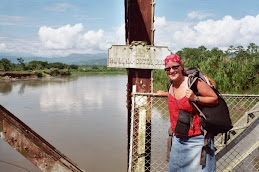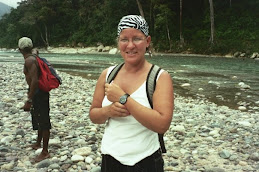Negation can be an effective identifier. If I say, for example, “I’m not that kind of girl,” we all understand what kind of girl I am. Or what I say I am. During my two years of adrenaline-induced bliss as a marathoner, I called myself a runner, but not a fast one. The distinction was important. Don’t expect me to win any races. Don’t invite me to run with you if you’re doing 7-minute miles. Or 8-minute miles. Or 9-minute miles, for that matter.
For the past few years, I’ve built my identity on a negation. I have alopecia, not cancer. I am hairless, not a chemo patient.
As a bald girl in a scarf, I’d often been mistaken for a cancer patient. That’s what people know. Bald head + headscarf = chemo. It was an honest mistake, one I sometimes felt responsible for. If only I could be comfortable in a hot, scratchy, heavy, expensive wig, then people wouldn’t have to be so uncomfortable with me. If only I could tolerate a wig, then people wouldn’t falsely assume I was part of the cancer sisterhood. Or in October, the breast cancer sisterhood.
The deluge of pink that occurred every year at this time—from cereal boxes to football jerseys—would heighten awareness about breast cancer and compel strangers to show me their support. Instead of the Knowing Look from afar, I would get Pep Talks from survivors and their families. I would get pats on the back, a grasp of hands, tears welling in someone’s eye. In October, more than any other time of year, people wanted to connect—not to what I was, but to what I was not.
Aware of the confusion and not wanting to contribute to it further, I tried to distance myself from the cause. I stopped Racing for The Cure years ago, when I first started wearing headscarves. I avoided wearing pink during Breast Cancer Awareness Month, just so I wouldn’t mislead anyone. Last year, I purposely didn’t buy the pink breast cancer awareness appointment calendar I’d eyed at the office supply store. My choices all centered around one message: I am not them.
Last October for the first time I finally sat down to write about sharing a Signature Look with cancer patients. I reflected on what it’s like to hear “at least it’s not cancer” over and over again, as if that’s somehow comforting, as if I didn’t say the same words to myself when I found myself grieving over the hair loss and then feeling guilty for my grief. I thought about all the times I’d heard people respond to a chemo patient’s concerns about hair loss with an “at least it will grow back.” I was thinking about how I might reconcile the two. I pondered the audacity of being a bald woman in a scarf and yet not having cancer. That’s what a stranger said to a friend who’s had alopecia her whole life. A young woman who’s never had to shampoo or blow dry or shave a single hair. Ever. A fellow alopecian who’s managed to grow up confident and self assured and beautiful despite not having hair. How dare you have the audacity, said the stranger, to parade your bald head around Target and not have cancer. How dare you garner my sympathy and concern when you don’t deserve it.
It felt like an important topic, an exploration worthy of resurrecting this neglected blog. But when the time came to hit the post button, I couldn’t do it. It didn’t feel right. Or it didn’t feel like the right time.
The problem with basing your identity on a negation is that it can be hard to maintain. The not-fast runner improves. The not-that-kind-of-girl becomes exactly the girl she once disdained. By choice or necessity, it doesn’t matter. In an instant the "not" you’ve clung to can slip out of your grip. You become what you were once not.
Two days after last year’s Breast Cancer Awareness Month wrapped up, my doctor found a lump in my breast. In mid November, I was diagnosed with breast cancer.
I’ve been reluctant to broadcast the news. Despite being completely open about my alopecia, I’m still a very private person when it comes to my personal life. Opening up private medical records on a public forum is risky for all the reasons you might imagine. Most importantly, though, despite going through surgery and chemo and radiation, I still identify more with alopecia, not cancer. Hairless, not chemo patient. I’ve been making that distinction for so long—one, not the other—that now I can’t seem to embrace both, alopecia and cancer.
Earlier this year in an interview with Ellen DeGeneres, Wanda Sykes, long time comedienne and now celebrity breast cancer survivor, talked openly about her diagnosis for the first time. In the beginning, she said, she kept it quiet. “How many things could I have? I’m black, then lesbian. I can’t be the poster child for everything!”
Sometimes you don’t have a choice.
Like Sykes, I have what sometimes seems like too many things. I can’t be the poster child for all of them. But that doesn’t mean I have to live in denial either. I don’t have to continue clinging to the "not" when it no longer applies.
I’ve neglected this blog for the past year in part because I haven’t known how to continue representing the "alopecia, not cancer" perspective when I'm no longer "not" cancer. I haven't known how to be authentic and true and still keep the "not cancer" shift a secret.
If there's one thing my alopecia has taught me, it's that The Closet is a dark and lonely place. So on this last day of Breast Cancer Awareness Month, I am coming out as yet another survivor.
My hair didn’t fall out because of chemo, and it’s not going to grow back now that I’m done with treatment. After sixteen years without hair, I don’t expect to ever have hair again. I don’t know how being a breast cancer survivor will change my platform or my message. I don’t know if I’ll write about it or be outspoken about it. I don't know that I'll ever be its poster child. But I know better than to say never.
What I'm sure about is this: being a breast cancer survivor will infiltrate my sense of self. It will affect how I see myself and how I present myself.
The good news is that because of my alopecia, I’ll be more prepared for the shift.
 Step 1: Lay out a square bandanna or scarf. Yes, a square. Which limits you, because a lot of scarves sold today are rectangular. Save those lovely rectangular scarves to wear around your neck. My favorite fabric is rayon batik, because it has a nice drape and the pattern is the same on both sides. Cotton batik is also nice, but the drape is a bit stiffer. A standard 100% cotton bandanna is fine and will soften over time, especially if you dry it in the dryer. Wool is scratchy against my sensitive scalp and silk doesn't like to stay in place on a bare head. But that's just me. What works for you will depend on how much hair you have, how itch tolerant you are, and what look you're going for.
Step 1: Lay out a square bandanna or scarf. Yes, a square. Which limits you, because a lot of scarves sold today are rectangular. Save those lovely rectangular scarves to wear around your neck. My favorite fabric is rayon batik, because it has a nice drape and the pattern is the same on both sides. Cotton batik is also nice, but the drape is a bit stiffer. A standard 100% cotton bandanna is fine and will soften over time, especially if you dry it in the dryer. Wool is scratchy against my sensitive scalp and silk doesn't like to stay in place on a bare head. But that's just me. What works for you will depend on how much hair you have, how itch tolerant you are, and what look you're going for. Step 2: Fold the square tip to tip to form a triangle. If it's a large scarf like the pañuelos my mother sews for me (27"x27"ish or more), proceed to step 3.
Step 2: Fold the square tip to tip to form a triangle. If it's a large scarf like the pañuelos my mother sews for me (27"x27"ish or more), proceed to step 3.


 Step
4: Tighten the flat end across your forehead. Play with positioning so
that you get the amount of forehead you want to show. Some people prefer their
headscarves low; others like them at the hairline so they're able to display
their entire forehead. Place your scarf where you feel most comfortable.
Step
4: Tighten the flat end across your forehead. Play with positioning so
that you get the amount of forehead you want to show. Some people prefer their
headscarves low; others like them at the hairline so they're able to display
their entire forehead. Place your scarf where you feel most comfortable.

















